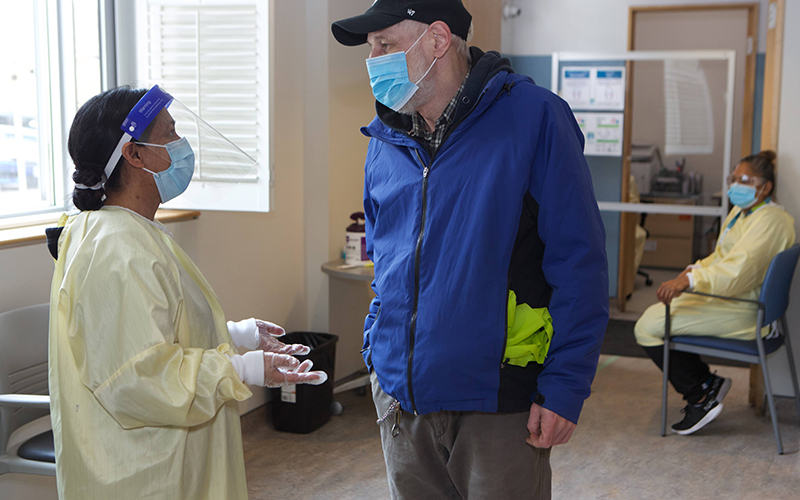The COVID-19 pandemic had profound, worldwide impacts on people’s physical and mental health. In late 2021, Statistics Canada released findings from its Survey on COVID-19 and Mental Health. It found that one in four Canadians over the age of 18 screened positive for depression (19%), anxiety (15%), or post-traumatic stress disorder. As well, 83% of Canadians experienced a negative impact due to the pandemic, such as feelings of loneliness or an increase in physical health problems.
At SRCHC, within just the first year of the pandemic, the social services team at SRCHC had 25% more interactions with clients. Other programs were also affected by our clients’ mental health needs, from harm reduction to food centre services to health promotion and more.
SRCHC responded to these increasing needs in a variety of ways including shifting services to a mixed on-site/virtual model and developing new programs to support community members.
Jay Baum, a registered dietician at SRCHC, says that the pandemic changed the way we work with clients on a day-to-day basis. Although some of the changes have been challenging, others have resulted in improvements to client care. Embracing virtual care, for example, has allowed allied health workers to stay more connected to some of their most vulnerable and isolated clients. With the addition of phone and video appointments, health workers at SRCHC can now provide shorter, more frequent check-ins for clients, many of whom have expressed gratitude for the regular touchpoints with their providers. Virtual care has opened up a whole new way of supporting our clients and helping them remain linked to their diabetes care community.
The centre also ran Mind Your Food, a hands-on program designed to promote positive mental health in youth. Participants explored the intersections of food, body, mind, identity, and social belonging. Youth learned through building their cooking skills and nutrition knowledge, sharing food traditions, connecting with the land, and finding ways to create positive community impact. The program provided a safe, welcoming, and fun space for youth during the pandemic. As one enthusiastic participant said, “The biggest difference for me is more confidence talking to people, because adults are not scary. It’s just that I was a really shy person, but now I feel a lot more confident in myself.”
Continuing to provide on-site services community outreach was also another important way that SRCHC programs and providers supported the mental and physical health needs of their clients. Harm reduction workers, community health workers, nurses, health promoters, overdose response workers, and client support workers were involved in a range of outreach activities. For many of our clients who are struggling with mental health issues and substance use and who have lost the support of in-person group sessions and drop-in spaces, being able to access one on one support has been essential.
Many of our Indigenous community members also depend on being able to connect with SRCHC’s Indigenous staff members. For example, we continued to conduct ceremonies with Indigenous community members outdoors, so that we could celebrate and connect with each other during a difficult time.
The staff at SRCHC were able to pivot during the pandemic and provide in-person and virtual services to our most marginalized clients, many of whom struggle mental health challenges. Our isolated clients reported to staff that sometimes even the most informal interactions, for example with our drivers delivering hot meals, had positive impacts for people that would otherwise be disconnected completely. As we move towards covid recovery we expect to see continued need to plan and respond to the mental health of our clients and community.

